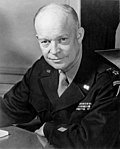This article needs additional citations for verification .(June 2016) |
| 1948 presidential election | |
  Nominees Dewey and Warren | |
| Convention | |
|---|---|
| Date(s) | June 21–25, 1948 |
| City | Philadelphia, Pennsylvania |
| Venue | Convention Hall |
| Candidates | |
| Presidential nominee | Thomas E. Dewey of New York |
| Vice-presidential nominee | Earl Warren of California |
The 1948 Republican National Convention was held at the Municipal Auditorium, in Philadelphia, Pennsylvania, from June 21 to 25, 1948.
Contents
- Platform
- Candidates before the convention
- Balloting
- Vice presidential nomination
- See also
- References
- External links
New York Governor Thomas E. Dewey had paved the way to win the Republican presidential nomination in the primary elections, where he had beaten former Minnesota Governor Harold E. Stassen and World War II General Douglas MacArthur. In Philadelphia he was nominated on the third ballot over opposition from die-hard conservative Ohio Senator Robert A. Taft, the future "minister of peace" Stassen, Michigan Senator Arthur Vandenberg, and California Governor Earl Warren. In all Republican conventions since 1948, the nominee has been selected on the first ballot. Warren was nominated for vice president. The Republican ticket of Dewey and Warren went on to lose the general election to the Democratic ticket of Harry S. Truman and Alben W. Barkley. One of the decisive factors in convening both major party conventions in Philadelphia that year was that Philadelphia was hooked up to the coaxial cable, giving the ability for two of the three then-young television networks, NBC and CBS, to telecast for the first time live gavel-to-gavel coverage along the East Coast. Only a few minutes of kinescope film have survived of these historic, live television broadcasts. [1]









